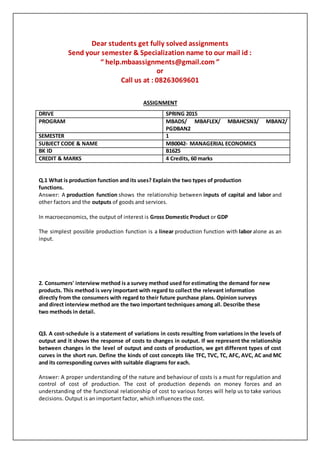
Get fully solved MBA assignments by subject experts
- 1. Dear students get fully solved assignments Send your semester & Specialization name to our mail id : “ help.mbaassignments@gmail.com ” or Call us at : 08263069601 ASSIGNMENT Q.1 What is production function and its uses? Explain the two types of production functions. Answer: A production function shows the relationship between inputs of capital and labor and other factors and the outputs of goods and services. In macroeconomics, the output of interest is Gross Domestic Product or GDP The simplest possible production function is a linear production function with labor alone as an input. 2. Consumers' interview method is a survey method used for estimating the demand for new products. This method is very important with regard to collect the relevant information directly from the consumers with regard to their future purchase plans. Opinion surveys and direct interview method are the two important techniques among all. Describe these two methods in detail. Q3. A cost-schedule is a statement of variations in costs resulting from variations in the levels of output and it shows the response of costs to changes in output. If we represent the relationship between changes in the level of output and costs of production, we get different types of cost curves in the short run. Define the kinds of cost concepts like TFC, TVC, TC, AFC, AVC, AC and MC and its corresponding curves with suitable diagrams for each. Answer: A proper understanding of the nature and behaviour of costs is a must for regulation and control of cost of production. The cost of production depends on money forces and an understanding of the functional relationship of cost to various forces will help us to take various decisions. Output is an important factor, which influences the cost. DRIVE SPRING 2015 PROGRAM MBADS/ MBAFLEX/ MBAHCSN3/ MBAN2/ PGDBAN2 SEMESTER 1 SUBJECT CODE & NAME MB0042- MANAGERIAL ECONOMICS BK ID B1625 CREDIT & MARKS 4 Credits, 60 marks
- 2. The cost-output relationship plays an important role in determining the optimum level of production. Knowledge of the cost-output relation helps the manager in cost control, profit prediction, pricing, promotion etc. The relation between cost and its determinants is technically described as the cost function. Q 4. Inflation is a global Phenomenon which is associated with high price causes decline in the value for money. It exists when the amount of money in the country is in excess of the physical volume of goods and services. Explain the reasons for this monetary phenomenon. Answer: Define Inflation- Inflation is commonly understood as a situation of substantial and rapid increase in the level of prices and consequent deterioration in the value of money over a period of time. It refers to the average rise in the general level of prices and fall in the value of money. Inflationisanupwardmovementinthe average level of prices.The opposite of inflationisdeflation, a downward movement in the average level of prices. The common feature of inflation is rise in prices and the degree of inflation may be measured by price indices. Inflation is statistically measured in terms of percentage increase in the price index, as a rate (percent) per unit of time- usually a year or a month. Q.5 Discuss the practical application of Price elasticity and Income elasticity of demand. Answer: Price elasticity of demand : Price elasticityof demand (PED or Ed) isa measure usedineconomics to show the responsiveness, or elasticity,of the quantitydemandedof agoodor service toa change initsprice.More precisely,it gives the percentage change in quantity demanded in response to a one percent change in price (ceterisparibus,i.e.holdingconstantall the otherdeterminants of demand, such as income). It was devised by Alfred Marshall. Applications of price elasticity : 1.Inelasticdemand for agricultural products helps to explain why bumper crops depress the prices and total revenues for farmers. 2.Governments look at elasticity of demand when 6. Define revenue. Explain the types of revenue and the relationship between TR, AR and MR with an example of a hypothetical revenue schedule. Answer: Revenue is the total amount received by a business or recognized as earned when the businesssellssomething, usually services and goods. In modern accountancy, revenue is recorded whenitis earnednotwhenthe cashis receivedfromcustomers.Forexample when a phone service providerrecordsrevenue whencallsare made notat the time when you pay the bills. This principle is known as revenue recognition principle.
- 3. Dear students get fully solved assignments Send your semester & Specialization name to our mail id : “ help.mbaassignments@gmail.com ” or Call us at : 08263069601
